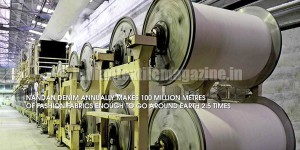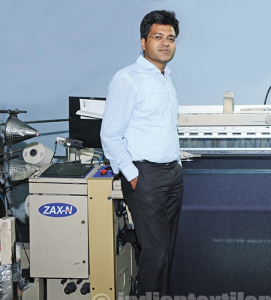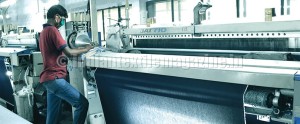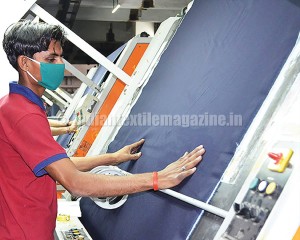Huge production capacity hike underway
 Nandan Denim Ltd., a part of the Rs. 3,000-crore Ahmedabad-based Chiripal Group, is on an expansion drive. It has initiated an major expansion which will help it move from being the second largest denim producer in India to the top spot, when the expansion is completed in March 2016.
Nandan Denim Ltd., a part of the Rs. 3,000-crore Ahmedabad-based Chiripal Group, is on an expansion drive. It has initiated an major expansion which will help it move from being the second largest denim producer in India to the top spot, when the expansion is completed in March 2016.
Nandan Denim was set up in 2004 at an investment of around Rs. 450 crores at a time when consumption of denim jeans was just perking up in India. Over a period of 10 years, it has been able to notch a turnover of Rs. 897.74 crores in FY 2103-14 with EBITDA amounting to Rs. 132.68 crores the same fiscal. Currently, it operates 27,000 spindles, 3,700 rotors and 471 automatic looms.
Nandan Denim is investing around Rs. 612 crores to expand the denim fabric capacity which will take its installed capacity from 70 million metres per annum to 110 million metres. For the first time, it is setting up facilities to produce 10 million metres per annum of yarn dyed shirting fabrics. A portion of the expansion will be done at its existing plant and the rest at the Chiripal Group-promoted Vraj Integrated Textile Park.

The Rs. 612-crore investment is to add 45,000 spindles, 3,300 rotors, more than 100 airjet looms and corresponding indigo dyeing plants. Post the expansion, the spinning capacity will more than double to 124 tons per day. The technology for the expansion for the spinning stage, like preparatory, would be coming from Truetzschler speed frames by Electrojet, ring frames from Rieter, winders by Schlahforst, and weaving machines from Japan and Belgium. Finally indigo dyeing machines will be a mix of indigenous and imported technology.
Explaining the evolution of denim jeans in India to The Textile Magazine, Mr. Deepak Chiripal, CEO of Nandan Denim, says: “Till the pre-2000 era, denim was considered an elite-class product, due to which denim fabric manufacturing capacity too was limited in India, with most of the denim jeans manufacturers importing the fabric from China.”
He adds: “Growth in the denim jean segment started post-2000, due to many factors, one among them being the cultural revolution that happened with the opening up of the media, due to which a lot of Western influence came into India. The new generation, which became influenced with these cultural changes, took to denim jeans in a big way.”
The new generation, according to him, was also influenced by Bollywood to a great extent where actors and actresses who earlier were shown in traditional Indian dresses were now being cast in various denim products like jeans, jackets, skirts, etc.
In the last few years, a lot of developments have also taken place in the look and feel of denim, which too has influenced growth. Nowadays, denim jeans are available in various finishes, colours, fits, etc., which too attracted the younger generation to denim, who now have multiple pairs in their wardrobe as against just 1 or 2 pairs or even none till a few years back.
Mr. Deepak feels that the retail revolution in India has also helped growth of the product in India, due to which denim jeans which were available earlier in only metro cities are now available in Tier I, II, III and even Tier IV towns and cities.
As against the retail price of a pair of denim jeans which started from Rs. 800 onwards earlier, denim jeans are now retailed at Rs. 350 onwards, and consumers have also began to understand that denim jeans are far more long lasting than the trousers made from conventional fabrics as they are more rugged.
“All these factors put together increased the per capita consumption of denim in India and made it a staple product. It will continue to grow in the next few years. All this made us optimistic about the prospects of the industry, prompting us to initiate this huge expansion of our denim capacity,” discloses Mr. Deepak.
When Nandan Denim was started in 2004, the installed capacity for denim fabrics in India was around 250 million metres per annum and had less than 10 companies producing them. The number has now skyrocketed to more than 30 players with a combined installed capacity of 1.3 billion metres per annum by 2016.
Nandan Denim markets 85 per cent of its denim fabrics in the Indian market, with the balance being exported to several countries. Going ahead and post the expansion, Nandan wants to hike its share of exports to 25-30 per cent of overall production, since the Government export drive as well as the depreciation of the rupee are also making exports lucrative.
Mr. Deepak says Nandan Denim is indeed competing against Chinese denim fabric exporters on the USP of its quality rather than price, which helped its products gain a premium over similar quality denim fabrics from China. Once Nandan Denim starts commercial production at the expanded plant, it plans to compete with China on the motto of ‘Better Quality, Lower Price’.
According to Mr. Deepak Chiripal, the company has clocked CAGR of 25 per cent since inception and hopes to maintain it till it commissions the new capacity. A lot of efforts are also going into changing the paradigm within and outside the organisation to build the image of a value-added supplier.
In doing so, it expects to bridge the gap between itself and other industry leaders in terms of per metre rupee realisation created due to the “mass product” image built by Nandan. The current gap is almost 35-40 per cent, and once it is able to bridge the gap, the company expects the CAGR trajectory to change, putting it ahead of the current industry leader.
Further, Nandan produces denim fabrics beginning from 4 ounce fabrics right up to 15 ounce fabrics, which find applications in a range of apparels like trousers, jackets, shirts, skirts, etc., and even school uniformwear.
In yarns, it also manufactures in cotton, both combed and carded, compact, slub, lycra, injunction slub, TFO, Eli-twist. In the fabric segment, Nandan produces denims, khakhis and other bottomwear fabrics in pure cotton and cotton blends and in shirting fabrics, it manufactures denim, yarn dyed and solid dyed categories.
With its state-of-the-art machinery, Nandan is able to produce a vast range of fabrics, which are also adaptable to changing market requirements. It also gets full support from its parent, Chiripal Group, confirming the possibilities of producing various products multifold and not bound by the limitations of being a pure-play denim player but a one-stop product provider to buyers of denim fabrics with a library of over 8,000 products.
On Nandan Denim being environmentally conscious, Mr. Deepak says: “Reducing our carbon footprint and thereby also cutting pollution levels year-over-year is an ongoing exercise since the day we started our plant.”
Over the years, the company has continuously upgraded its effluent treatment plant (ETP) by making it more efficient and thereby discharging waste as per the approved norms. It has also invested in technologies due to which the reuse of water is increasing with passage of years and upgrading technology has also helped it to consume lesser water during the fabric processing stage. Improving energy efficiency too is an ongoing process, with newer technologies being introduced from time to time.
Additionally, Nandan is also an Oeko-Tex certified company, which means the dyes and chemicals it uses are environmentally friendly. It has also been a pioneer in shifting to liquid indigo as against powder indigo, which creates a lot of sludge and, when released, creates vast environmental damage. So, although liquid indigo is expensive when compared with powder indigo, Nandan uses it since it does not create environmental damage.
Nandan Denim has no immediate plans of entering garment manufacturing, branding or retail. However, Mr. Deepak does not completely rule it out, saying the first priority is to complete the expansion project, after which adding value to the fabrics produced may be thought of.
The company supplies its products to major denim apparel brands, but does so indirectly through its distributors since the volumes are not large enough. Also, it is supplied to manufacturers who stitch for those brands and not to the brands directly.
Mr. Deepak adds that of the overall Indian denim apparel market, organised or branded denim products account for just 10 per cent, with the major portion accounted for by those in the unorganised sector.
Referring to the ‘Make in India’ program of the Narendra Modi Government, Mr. Deepak Chiripal observes that it would positively give a big boost to value-added textile exports. India will see most of its cotton exported getting converted into yarn by 2018, and most of this yarn will in turn be converted into fabrics by 2020.

